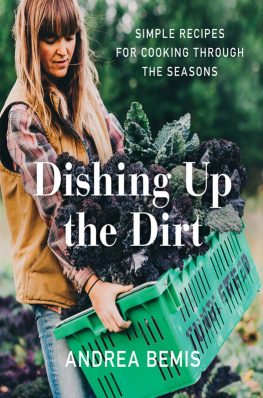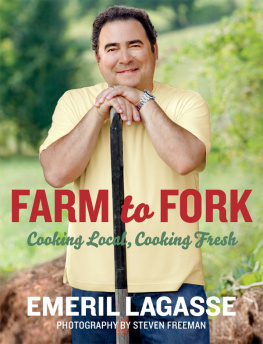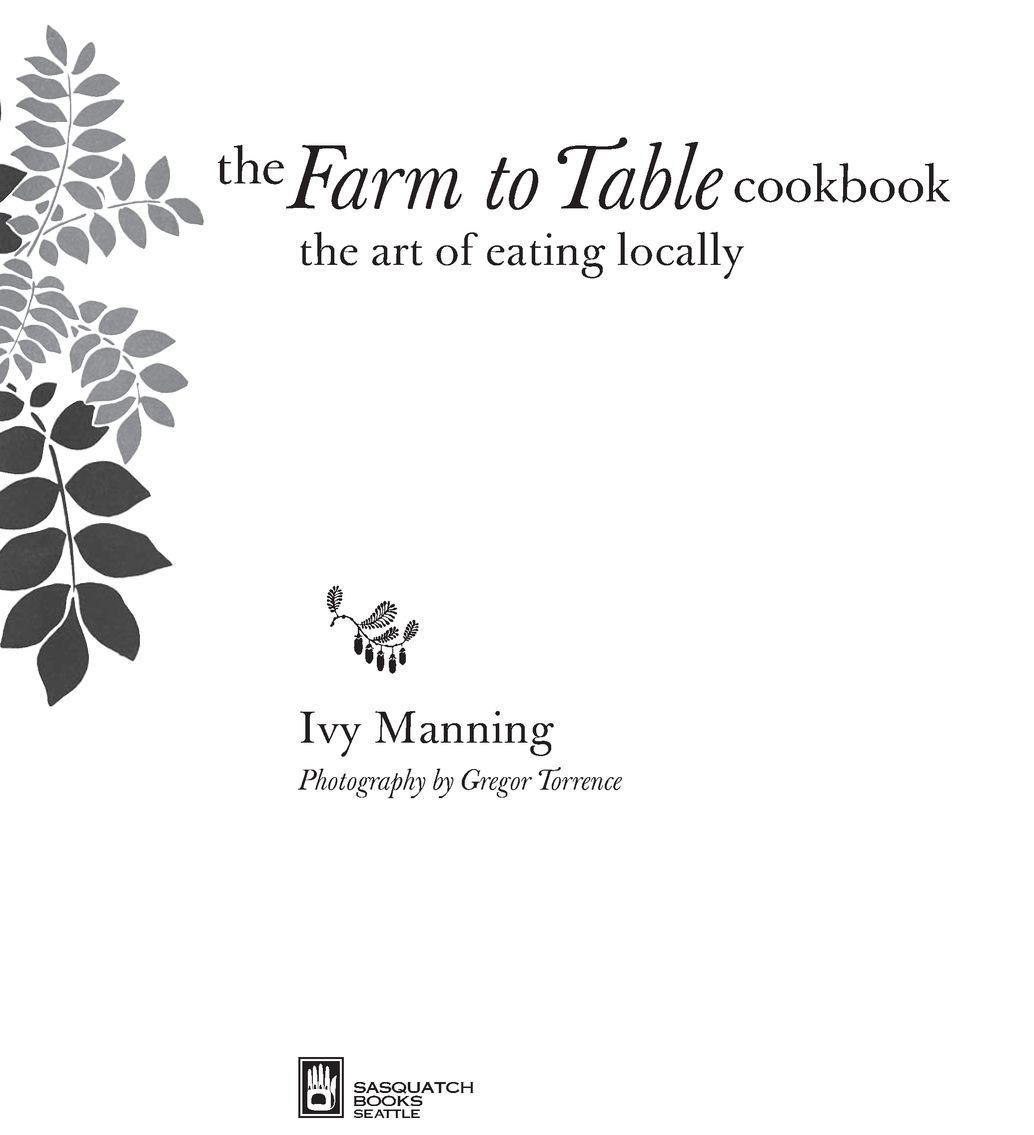Table of Contents
This book is dedicated to the farmers and vendors at farmers markets everywhere.
They get up early, get dirt under their nails, and stand in the blazing sun
and pouring rain to sell us the fruits of their backbreaking labor.
Blessed are the food growers, for we are always hungry.
ACKNOWLEDGMENTS
I would like to thank my husband, Gregor. This book would not exist without his immense patience, keen photographic eye, and ability to calm me during my many freak-outs. If we can do a book together in our first year of marriage without ending up in divorce court, just think what the future will bring....
Thanks to my brother, Andy Manning, and members of the chefivy.com newsletter for testing recipes and giving me honest feedback. Thanks also to my grandmother, Helen Zalubowski, who gave me my first wad of pizza dough to play with at age 3. Ive been hooked on cooking ever since.
Id like to express my immense gratitude to the busy chefs who contributed recipes; many didnt know me from Eve, but were happy to share their talent and spread the word about local ingredients and good food. Thanks also to the folks at Sasquatch Books, especially my editor, Gary Luke. He had the vision to see the book within me waiting to be born. Also, thanks to Rachelle Long for her patience, attention to detail, and long, humorous e-mails.
INTRODUCTION
A revolution is taking place in the way Americans eat. Many of us are turning away from highly processed foods and the chronic diseases that are caused by them. Instead, were turning to farmers markets and Community Supported Agriculture (CSA) programs to get fresh, locally grown food for our families. The words local and organic, seen only in grassroots co-ops a few decades ago, are now common at even the largest supermarkets, thanks to the demand weve created. This transition to locally grown organic foods, whether purchased at a farmers market or a grocery store chain, will make us healthier as a nation, provide support to local family farms, help save our environment, and rekindle our love affair with good food.
With change, however, comes challenge. The farmers market experience can be daunting. When we wander through the market, elbow to elbow with other foodies, its easy for us to be seduced by the gorgeous mounds of greens, the vibrant colors of unknown vegetables, and the aroma of sweet berries. Next thing we know, weve brought home more food than we know what to do with, and some of it may die a lonely death in the vegetable keeper because of lack of inspiration in the kitchen, no matter our good intentions.
So how do we take all that gorgeous food fresh from the farmers market, CSA box, or natural food store to the dining room table?
This book will help answer that question. Here youll find a seasonal guide of whats best at the market, from familiar favorites to vegetables you may never have heard of, with great recipes on how to use all of the bounty.
The chapters are grouped by season, which will help you get a feel for an intuitive way of cooking that uses ingredients when theyre at their peak. The How to Choose sections will help you get the best vegetable bang for your buck and help you navigate through the seemingly endless variations of ingredients so you can buy with confidence.
Ive also included a Meet the Producer section in each chapter. I do this in hopes of introducing you to some of the farmers and food artisans that Ive been lucky enough to befriend and be inspired by. By introducing them, I also hope to dispel the notion that all farmers are grumpy old men wearing overalls who face their long days of toil with resignation or bitterness. The passion, education, and youthful exuberance of Michael and Jill Paine, Pat Morford, Barb and Fritz Foulke, and Shari Surkin gives us a glimpse of the new face of farming in America. And despite their enormous challenges, individuals like these are reason to be very optimistic for the future of our food culture.
Recipes are based on my years of cooking and teaching in Portland, Oregon, combined with the knowledge and dedication of some of the Pacific Northwests best chefs. They are leading the charge toward a closer relationship between the farmers who grow our food and the people who consume it. I urge you to support chefs who are cooking with dedication to local and seasonal ingredients. Their expertise in buying farm fresh produce and meats is a guiding force in forming strong local farming communities, and their talent in the kitchen can inspire you to expand your culinary repertoire at home.
I hope this book will have you eager to cook meals using food grown by good stewards of our land. Some recipes are as simple as wrapping fresh figs with prosciutto and throwing them on the grill; others are sophisticated restaurant-style dishes, like elegant poached duck egg and asparagus salad with truffle oil. Let this book inspire you to shop seasonally, cook simply, and taste the food grown near you.
The Flavor of Farm to Table
Why get out of bed early on a weekend morning or join a CSA harvest-box program when the mega-supermarket is there for you with whatever you want whatever the season? Here are a few reasons to feel good about buying locally.
TASTE. Anyone whos ever savored an heirloom tomato still warm from the sun, or popped a berry into their mouths moments after plucking it, knows that food tastes better when it is in season. A strawberry that travels from a nearby farm directly to a farmers market can be picked when it is ripe and is more likely bred for its delicious flavor, not for its ability to pack without bruising. Locally grown food doesnt have to be fumigated, refrigerated, and packaged to survive a thousand-mile trip; it arrives to you in a more natural and tastier state.
CONNECTION. Americans have become increasingly isolated; were a nation of individuals separated by our cars, the music on our headphones, and our cell phones. Coming together over food is one of the best ways to know those around us. Talking face-to-face with the person who grew our food in a market setting is one more step toward interconnectedness.
DIVERSITY IN DIET. Corn, potatoes, carrots, and iceberg lettuce make up the majority of our meager vegetable intake. The USDA recommends eating five to seven servings of vegetables a day: eating a diversity of vegetables is key to preventing disease, according to the National Centers For Disease Control & Prevention. Its much easier to let go of old vegetable habits when theres more than flavorless waxed cucumbers and watery white lettuce available; farmers markets, CSAs, and grocery stores dedicated to selling locally grown products supply many more choices.
SUPPORTING FAMILY FARMS. According to data collected by Local Harvest, a nonprofit organization that promotes local food systems, only eighteen cents of each dollar spent at the supermarket makes it to the farmer who grew your food. The rest goes to transport, packaging, and marketers. The pressures of agribusiness and cheaper imported food are pushing family farms out of business at an alarming rate. By buying locally from smaller farms, we give farmers a fair price for their product and help their farms survive.
















